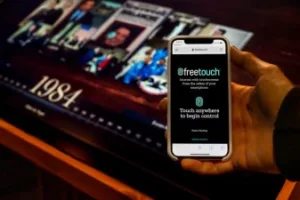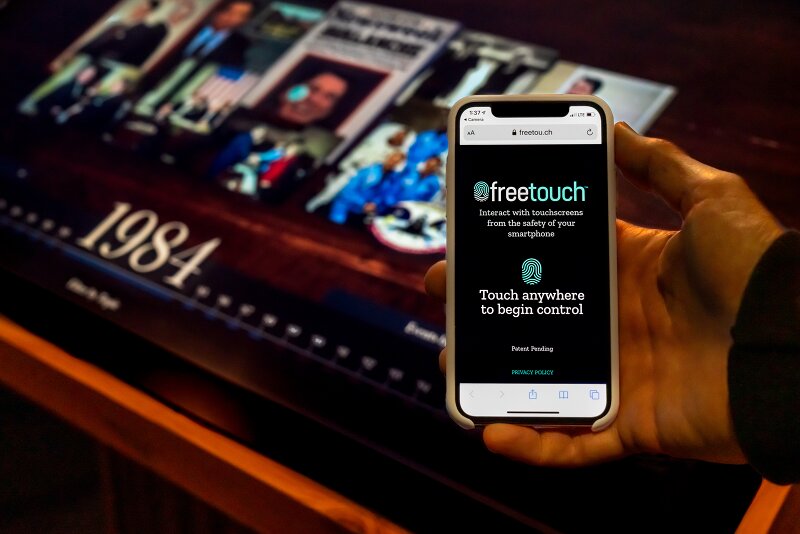There is no question that, especially since the arrival of the iPhone and iPad, the use of touch displays as an interface has become ubiquitous. However, the technology is not without its drawbacks, especially at a time of concern over disease transmission.
The region that I first heard of as resisting touch applications was Japan. In that country, where many live together in small spaces, I used to say that, to use a common expression in England ‘cleanliness is next to godliness’ (apparently first recorded in a sermon by John Wesley in 1778, but may go back to Babylonian and Hebrew tracts!). However, in Japan, cleanliness may be above godliness.
Because of the Japanese concern with cleanliness, some are concerned if asked to use touch systems because of the danger of disease. Although, as we have reported several times this year, there have been plenty of companies developing materials that kill the bacteria on touch screens. However, as far as I can tell, these materials can take a long time to work and touch systems have to be available all the time.
A couple of years ago, the topic became a hot one in other countries, especially after some research on the bacteria on touch screens in QSRs. (Synchronicity In the Dirt) Further, we have reported to our What Bob Saw subscribers that research has shown that the Covid-19 virus can stay active on touch surfaces for up to 28 days. (Covid-19: Virus can survive on touchscreens for 28 days)
The obvious alternative is to use ‘touchless touch’ and over the last few years, I have reported on several different approaches and I summarised the technology and its pros and cons in this article Covid-19 and Touchless Touch). However, although my policy of ‘don’t bet against the engineers’ suggests that eventually completely contactless touch with clear haptic feedback and with a standardised ‘grammar’ may eventually become available at a cost low enough to be widely used in kiosks, we are some way from that at the moment.
Alternatives
So, what are the alternatives? One way is to provide cleaning facilities for the displays. However, that is always going to be labour intensive to maintain.
(I’m reminded that when mirror touch-displays have been used in high end clothing retailers, they have to be cleaned every 15-20 minutes. That may be, just about, acceptable in a very high end fashion boutique in Milan, London, Paris, New York or Tokyo, but not anywhere else)
I have thought for a while that the best way is to allow users to access touch systems using their personal devices. Even my wife, who hates technological solutions, has a smartphone now (to keep up with the extended family on Whatsapp, mainly, but also to allow access to WhatThreeWords as she organises group walks where the walkers are likely to be away from roads and she might need to get emergency help!)
This seems to me to be an obvious thing to do, but the challenges are significant. The smartphone needs to connect to the terminal. In an ideal world that could be by bluetooth, with connections set up by NFC. Tap on the kiosk and you connect. But that would need either an app or a standardised process. An app means a need for downloads and installation. Not good. Standardisation is really difficult, too.
Most kiosks these days and, I suspect, all recent kiosks have internet access, the other way to connect is via the cloud.
That’s what Freetouch Inc has introduced in its new product. I have listed the features, which include
- Any (modern) smartphone – iOS or Android (& tablets)
- No app download required – Runs in mobile web browsers
- Works on mobile networks – End-users don’t need to join local Wi-Fi
- Installs in minutes – No special hardware or programming needed
- Responsive and easy to use – Works just like a laptop touchpad
- Secure connectivity – All communications encrypted via SSL
- 100% contactless – Users never have to touch the shared display
- Instantaneous connection – Just use the QR code
- No end user learning curve – No gestures to learn (or perform)
- Zero maintenance required
- Completely anonymous – No login or signup required for end users
- Customizable controls – Features available on a per-system basis
Now, that list has been taken from the firm’s sales literature, but it does answer most of the questions I would have if I wanted to use it.
I can see several potential disadvantages, dealing with different shapes and resolutions and its not clear that the system supports any kind of haptic feedback. Touch systems can be very frustrating if they don’t seem to do what the user wants them to, or if they accept multiple inputs because an initial input did not seem to be recognised.
Still, this development does point to a way to allow touch access, while keeping users safe. (BR)


